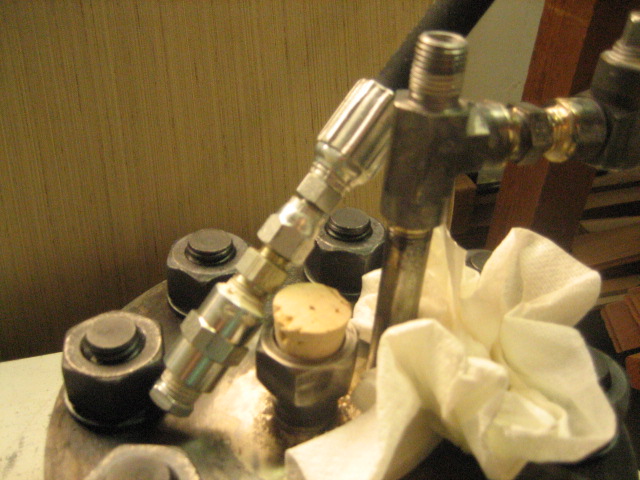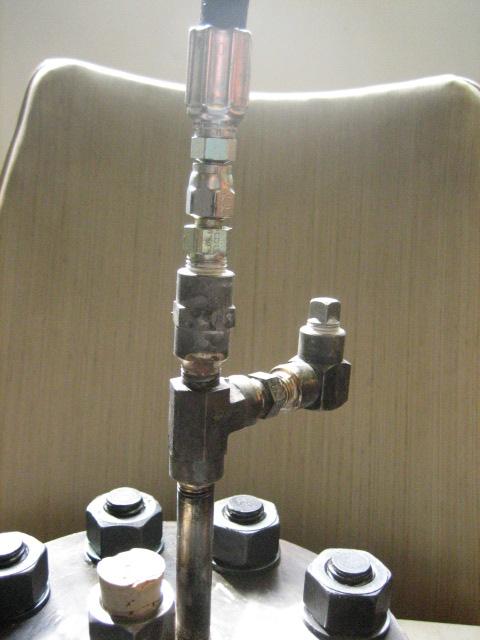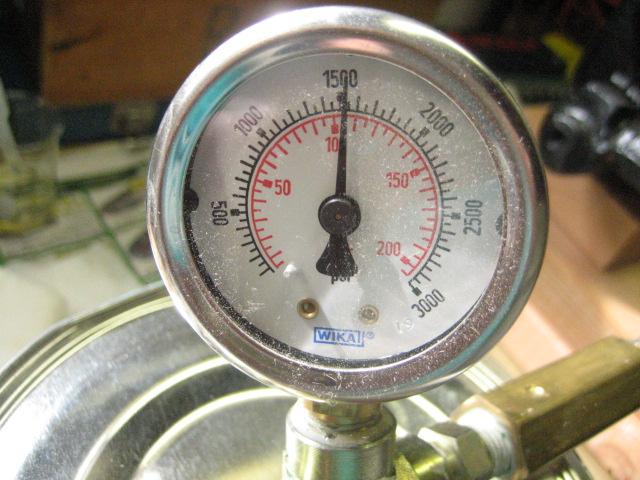| Pages:
1
2 |
Magpie
lab constructor
    
Posts: 5939
Registered: 1-11-2003
Location: USA
Member Is Offline
Mood: Chemistry: the subtle science.
|
|
Quote: Originally posted by merrlin  |
At this point I would be inclined to epoxy a stainless 1/4NPT coupling to the male stub at the tee. Before epoxying the coupling, I would plug the
coupling and attach it to the hose with PTFE tape and pressure test it. That way you can verify the coupling before epoxying it to your existing
plumbing. |
I'm thinking along these lines myself. Only I would use silver solder instead of epoxy as I don't want the maximum service temperature to be limited
anymore than necessary. Although using the solder would be a lot more work and expense than would be the epoxy.
Another advantage to the coupling will be the female threads. These are needed for the pressure relief device that will form the "plug" in service.
|
|
|
Magpie
lab constructor
    
Posts: 5939
Registered: 1-11-2003
Location: USA
Member Is Offline
Mood: Chemistry: the subtle science.
|
|
Strongly suspecting bad threads at the tee/FNPT-JIC connection I carried out the test proposed by merrlin and myself. That is, the female JIC on the
hose end was connected to a nipple (NPT/JIC), NPT coupling, and plug as shown below. This system was then brought up to 1500 psig. All 9 threaded
connections held.
Pressure would slowly drop off as various compression fittings were leaking slightly at these higher pressures. They were tightened and the leaks
stopped. Finally a threaded connection at a brass pressure gage did start slowly leaking. I terminated the test at this point.
I now feel that if the NPT coupling is epoxied or silver soldered to the 1/4" MNPT at the tee on the autoclave (see picture) I will be able to proceed
with hydrostatic testing of the autoclave itself to 1500 psig.
Thanks to all those contributing suggestions to help me seal this system.

[Edited on 18-8-2010 by Magpie]
[Edited on 18-8-2010 by Magpie]
|
|
|
Magpie
lab constructor
    
Posts: 5939
Registered: 1-11-2003
Location: USA
Member Is Offline
Mood: Chemistry: the subtle science.
|
|
Quote: Originally posted by Magpie  |
I now feel that if the NPT coupling is epoxied or silver soldered to the 1/4" MNPT at the tee on the autoclave (see picture) I will be able to proceed
with hydrostatic testing of the autoclave itself to 1500 psig.
|
This is a followup to the leak that I could not stop before on the autoclave tree.
I did have a coupling silver-soldered to what I suspected were bad male threads on the tee. Today I pressure tested the system again. It held 1500
psig for 15 minutes with no leaks. So I now consider the autoclave to have successfully passed its hydrostatic pressure test.
As always comments, suggestions, and questions are welcomed.
 
The single most important condition for a successful synthesis is good mixing - Nicodem
|
|
|
Eclectic
National Hazard
   
Posts: 899
Registered: 14-11-2004
Member Is Offline
Mood: Obsessive
|
|
I'd go with silver solder every time...
Awww...come on...I built an autoclave designed for 50,000 psi
5 inch diameter 316+ cold rolled, 2" bore...
17-4 ph alloy is widely used in Autoclave Engineers high pressure fittings.
[Edited on 9-18-2010 by Eclectic]
|
|
|
Magpie
lab constructor
    
Posts: 5939
Registered: 1-11-2003
Location: USA
Member Is Offline
Mood: Chemistry: the subtle science.
|
|
Let's see it....and your pressure test. 
What is 17-4 ph alloy? And how does it compare in cost and availability to SS316 fittings?
[Edited on 18-9-2010 by Magpie]
The single most important condition for a successful synthesis is good mixing - Nicodem
|
|
|
watson.fawkes
International Hazard
    
Posts: 2793
Registered: 16-8-2008
Member Is Offline
Mood: No Mood
|
|
http://www.specialtysteelsupply.com/17-4ph-stainless-steel.php
http://www.sandmeyersteel.com/17-4PH.html
|
|
|
denatured
Hazard to Others
  
Posts: 151
Registered: 7-8-2004
Location: -
Member Is Offline
Mood: HCl 50%?
|
|
Have you tried using flax fibers w/ PTFE? it is very strong. like this and this.
|
|
|
Eclectic
National Hazard
   
Posts: 899
Registered: 14-11-2004
Member Is Offline
Mood: Obsessive
|
|
http://www.autoclaveengineers.com/products/pressure_vessels/...
AE Style Closure. I can take photo of closure, alas, not body.
Pressure test would have required a 100 ton hydraulic press and special 1/2 sq inch piston modified plug
Patent US2424449
|
|
|
Magpie
lab constructor
    
Posts: 5939
Registered: 1-11-2003
Location: USA
Member Is Offline
Mood: Chemistry: the subtle science.
|
|
Flax? That's an interesting suggestion. But my joints are now holding with just the Ace PTE joint sealing compound.
If your threads aren't right I'm now convinced the joint will leak no matter what sealant you use. And if your threads are really great you may not
even need one. When you tighten to deformation you are really getting a compression seal. But the root-to-peak spiral still must be sealed, I
suppose.
@Eclectic
OK, I believe you. Nice equipment, but likely nearly as expensive as Parr.
[Edited on 19-9-2010 by Magpie]
[Edited on 19-9-2010 by Magpie]
The single most important condition for a successful synthesis is good mixing - Nicodem
|
|
|
Eclectic
National Hazard
   
Posts: 899
Registered: 14-11-2004
Member Is Offline
Mood: Obsessive
|
|
Your pressure range would likely be happier using hydraulic line 10,000 psi designed fittings, but you seem to have it working ok using much cheaper
standard plumbing.
|
|
|
Magpie
lab constructor
    
Posts: 5939
Registered: 1-11-2003
Location: USA
Member Is Offline
Mood: Chemistry: the subtle science.
|
|
Quote: Originally posted by Eclectic  | | Your pressure range would likely be happier using hydraulic line 10,000 psi designed fittings, but you seem to have it working ok using much cheaper
standard plumbing. |
Those are hydraulic fittings. Some have JIC compression ends and some have NPT ends.
The single most important condition for a successful synthesis is good mixing - Nicodem
|
|
|
denatured
Hazard to Others
  
Posts: 151
Registered: 7-8-2004
Location: -
Member Is Offline
Mood: HCl 50%?
|
|
Magpie: before PTFE appeared, it was widely used by plumbers (ex). even if your threads are great, you need some sealing, even if it is a thin layer.
|
|
|
Magpie
lab constructor
    
Posts: 5939
Registered: 1-11-2003
Location: USA
Member Is Offline
Mood: Chemistry: the subtle science.
|
|
Quote: Originally posted by denatured  | | Magpie: before PTFE appeared, it was widely used by plumbers (ex). even if your threads are great, you need some sealing, even if it is a thin layer. |
Yes, I agree. With the NPT design some sealant is required as nicely explained by watson upthread.
Flax is an interesting approach. Perhaps shredded dental floss would also work in a like manner. For general household water plumbing I have always
used either Rectorseal No. 7, Ace PTE, or Teflon tape. If the threads are good they all seem to work satisfactorily.
Rectorseal No. 7 has been the industrial favorite for decades in the US. Mine was given to me by a millwright in a paper mill where I once worked.
The single most important condition for a successful synthesis is good mixing - Nicodem
|
|
|
SWilkin676
Hazard to Self
 
Posts: 68
Registered: 3-2-2010
Member Is Offline
Mood: No Mood
|
|
I'm curious how ptfe will hold up under pressure and high temp. I thought it had a relatively low temperature threshold compared to the kind of
things chemists (especially mad ones) like to do.
I also thought JIC & NPT aren't meant to go together. I've learned the hard way the subtle differences between the threading types - you can
sometimes get it part way but anything else you damage the threads to accomplish because of the differences in pitch angles etc.
http://www.malonespecialtyinc.com/tech.htm
We got introduced to the fun of different types of plumbing fittings when we got a leybold vacuum pump with BSP fittings. I have a brazed plate heat
exchanger I can't play with til I get ahold of 4 ISO 1" fittings. Ugh.
|
|
|
Magpie
lab constructor
    
Posts: 5939
Registered: 1-11-2003
Location: USA
Member Is Offline
Mood: Chemistry: the subtle science.
|
|
Quote: Originally posted by SWilkin676  | I'm curious how ptfe will hold up under pressure and high temp. I thought it had a relatively low temperature threshold compared to the kind of
things chemists (especially mad ones) like to do.
I also thought JIC & NPT aren't meant to go together. I've learned the hard way the subtle differences between the threading types - you can
sometimes get it part way but anything else you damage the threads to accomplish because of the differences in pitch angles etc.
|
As you say organic materials are usually limited to about 300C if not less, and I will be limited to applications below those temperatures.
When I said that some ends are JIC and some are NPT I did not mean to imply that I was mating the two.
The single most important condition for a successful synthesis is good mixing - Nicodem
|
|
|
| Pages:
1
2 |